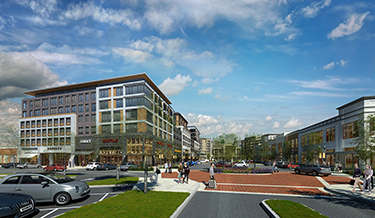|
Subscribe / Renew |
|
|
Contact Us |
|
| ► Subscribe to our Free Weekly Newsletter | |
| home | Welcome, sign in or click here to subscribe. | login |
Architecture & Engineering
| |
 |
October 3, 2019
How understanding building codes can help you get more out of your project
Code Unlimited

|
How often have you had to downsize a project because building codes required you to provide setbacks, limit the building height, or otherwise restrict your design?
Take for example, the Village at Totem Lake, a recent project in downtown Kirkland. The structure was originally built in 1973 as an enclosed two-story mall space with limited interconnectivity and aging aesthetics. The proposed upgraded design plans included a seven-story podium building with retail on the ground floor, parking, and three levels of residential occupancy.
It was inevitable that a project of this size and complexity would face issues with limitations due to existing structures and code restrictions. For example, a key constraint was an existing retail building of combustible construction right next door to the new structure.
Defining the problem
Anyone who has worked in the shrinking space of the Seattle metro area knows that every foot farther from the property line you build means fewer square feet of leasable retail and residential space. Depending on the amount of square footage, this could make the difference between financial success or failure for the project.
For the Village at Totem Lake, this issue was solved through a step-by-step approach and analysis, starting with a thorough design review to clearly define the problem.
“This was fairly unique for this project because the owner chose to subdivide the lot into parcels, creating the lot lines which therefore created code restrictions on unprotected openings abutting the lot line and above the adjacent roof,” said Chris Wayburn of GBD Architects, the leading firm for the project.
The second step of this type of approach is to consider the parameters. The local building official was not only experienced and knowledgeable about the building code, but also willing to consider well-reasoned arguments that could demonstrate the project would maintain appropriate levels of safety.
However, for a presentation of a code appeal to be successful, the presenter must have a thorough understanding of the codes involved and the fire science behind them. The capabilities, knowledge and perspectives of the local officials need to be considered alongside every facet of the appeal, including any potential concerns or perceived shortfalls of the strategy being put forth.
Once the problem and stakeholders have been defined, the third step of finding a solution through research and analysis can be put into action.
In this case, an assumed lot line was being introduced, requiring a simulation of building up to the edge of the property line to gather data. While adjustments could not be made to the preexisting building’s firewalls, a plan for the new building could be developed through heat-transfer analysis — to document the thermal resistance of the exterior walls during a simulated fire using computational fluid dynamics.
At this location, the new proposed design consisted of a 3-hour-rated wall surmounted by a 3-hour-rated horizontal barrier supported by 3-hour fire-resistance-rated columns, which is not specifically addressed by the code. This further established the need for customized fire model to confirm that the horizontal barrier would provide protection.
Although in reality the fire would burn out once the entire fuel was consumed, a conservative approach was chosen wherein the fire was allowed to continue at the peak heat-release rate for the duration of the run. Also, although sprinkler protection was to be provided for the area, the fires were modeled without sprinkler protection to produce the most extreme case, where sprinklers fail to control the fire.
Extra precautions
Despite the worst-case scenario fire model parameters selected, the resulting temperature profiles and calculations showed that the proposed design functioned equivalently or better than a code-prescriptive, continuous 3-hour fire wall separating the two buildings.
However, even with this analysis, extra precautions were taken.
Wayburn said, “As part of this project Code Unlimited worked directly with the jurisdiction and our sprinkler contractor to develop the sprinkler curtain for the lower portion for the building. The city required this compromise, so the code consulting crew acted as intermediaries between the sprinkler design builder and the local jurisdiction to come up with a water curtain design that was acceptable to all parties.”
In addition, a 15-foot “no build” covenant was established for future planning in order to address unprotected openings in exterior walls.
“This allowed the application of restrictive covenants on to the adjacent property to prevent vertical development in the future — which allowed us unprotected openings,” Wayburn said.
Unique conditions such as this one found at The Village at Totem Lake are becoming more common, with property values and exchanges continuing to evolve, and designers pushing the boundaries of the industry.
While the building code can be a good guideline for generic and prescriptive life safety, thorough planning along with research-backed appeals and engineering judgments offer the opportunity for the code to evolve as well.
Vince Collins is a principal and fire protection engineer at Code Unlimited. Collins has more than 30 years of experience with building code, fire protection systems, jurisdictional communications and hazardous materials in multiple market sectors.
Other Stories:
- Why electric scooters could be a game changer for Seattle
- CLT: construction’s lean, green beauty queen
- The AEC industry has a data problem
- What our evolving mobility options mean for designers and developers
- New OSU-Cascades academic building will aim for net zero
- Mass timber is bringing the warmth of wood to the workplace
- With so many tech advances, why has AEC productivity growth stalled?
- Survey: Cary Kopczynski & Co.
- Survey: Weber Thompson
- Survey: Johnston Architects
- Survey: Bohlin Cywinski Jackson
- These 3 Northwest projects show how listening to clients pays off
- Which project delivery methods work best?
- How successful workplaces offer more than just a place to work



